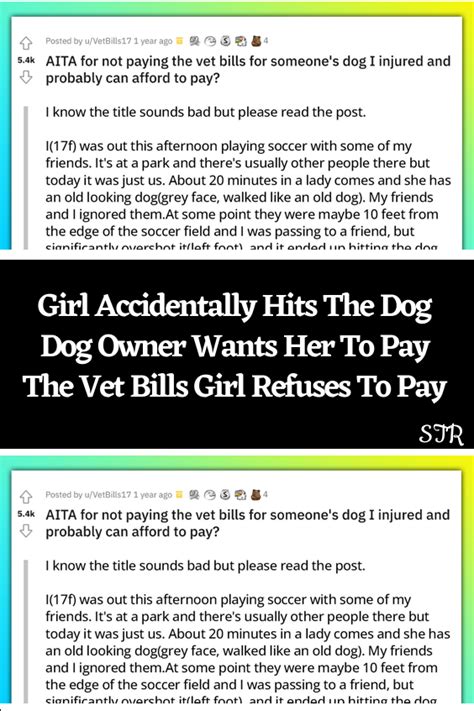
A dog seemingly refusing to pay its veterinary bill has become an internet sensation after a video of the incident went viral. The footage shows the dog’s owner jokingly demanding payment, sparking amusement and widespread discussion online.
A lighthearted video showing an owner playfully confronting their dog about an unpaid veterinary bill has captured the internet’s attention, rapidly accumulating views and comments across various social media platforms. The video, which originated on TikTok, depicts the owner jokingly demanding payment from their canine companion, who appears remarkably unfazed by the accusation. The incident, while clearly staged, has resonated with pet owners and animal lovers alike, prompting discussions about the rising costs of pet care and the unique bond between humans and their animal companions. The video’s virality underscores the power of relatable content and the universal appeal of humorous animal antics in the digital age.
The video, shared widely across platforms like X (formerly Twitter) and Instagram, features the owner engaging in a mock confrontation with their dog. “Excuse me, sir, do you have the $400 you owe the vet?,” the owner is heard asking in the video, prompting the dog to look away, seemingly avoiding the financial inquiry. The owner continues, “You went in for a checkup; you need to pay your bills.” The dog’s nonchalant reaction, characterized by its apparent disinterest in the financial matter, has contributed significantly to the video’s comedic appeal.
The video quickly gained traction, amassing millions of views and eliciting a flurry of responses from viewers. Many found the scene humorous and relatable, sharing their own experiences with pet ownership and the associated expenses. Others commented on the dog’s seemingly guilty expression, interpreting its behavior as an acknowledgment of the outstanding debt. The video has also sparked a broader conversation about the increasing costs of veterinary care and the financial responsibilities that come with owning a pet.
“This is hilarious! My dog does the same thing when I ask him to pay for his toys,” one user commented on the video. Another wrote, “The side-eye is real. That dog knows exactly what he did.” Several users also used the opportunity to share anecdotes about their own pets’ medical bills, highlighting the financial challenges faced by many pet owners.
The video’s popularity highlights the growing trend of pet-related content dominating social media. Animals, particularly dogs and cats, have become ubiquitous figures on platforms like TikTok, Instagram, and YouTube, capturing the attention of audiences with their endearing antics and humorous behavior. This trend reflects the increasing role of pets in modern households and the strong emotional connections that people form with their animal companions.
Beyond the entertainment value, the viral video also serves as a reminder of the significant financial commitment involved in pet ownership. Veterinary care, including routine checkups, vaccinations, and emergency treatments, can be expensive, placing a strain on many pet owners’ budgets. The rising costs of pet food, supplies, and other pet-related services further contribute to the overall financial burden. As a result, many pet owners are seeking ways to manage their expenses, including purchasing pet insurance, utilizing veterinary discount programs, and exploring alternative treatment options.
The American Veterinary Medical Association (AVMA) estimates that pet owners spend billions of dollars on veterinary care each year. According to a recent survey, the average annual cost of veterinary care for a dog ranges from $200 to $400 for routine checkups and vaccinations, and can exceed $1,000 for emergency treatments or specialized care. The cost of veterinary care varies depending on several factors, including the pet’s breed, age, health condition, and geographic location.
The increasing costs of veterinary care have prompted discussions about the need for more affordable and accessible pet healthcare options. Some organizations are advocating for policies that would expand access to veterinary services for low-income pet owners, while others are promoting the use of telemedicine and other innovative technologies to reduce costs and improve access to care.
The viral video of the “debtor dog” serves as a lighthearted reflection of the realities of pet ownership in the modern world. While the scene is clearly staged for comedic effect, it touches upon a serious issue: the financial responsibilities that come with caring for an animal companion. The video’s popularity underscores the importance of responsible pet ownership and the need for pet owners to be prepared for the financial challenges that may arise.
The owner’s playful demand highlights the often-humorous ways people interact with their pets, treating them as members of the family with distinct personalities and quirks. The dog’s seemingly indifferent response adds to the comedic effect, creating a relatable scenario for pet owners who have experienced similar interactions with their own animals. The video’s virality speaks to the power of humor and relatable content in capturing the attention of online audiences.
The internet is awash with similar videos of pets engaging in amusing behaviors, reflecting the growing trend of anthropomorphism, or attributing human traits and characteristics to animals. These videos often depict pets engaging in activities such as talking, singing, dancing, and even “working” at human jobs. The popularity of these videos suggests that people enjoy projecting human qualities onto their pets and finding humor in their perceived behaviors.
The video also highlights the role of social media in shaping public perceptions of animals. Through viral videos and online content, animals are increasingly portrayed as intelligent, emotional, and capable of complex behaviors. This portrayal can contribute to a greater appreciation for animals and promote more responsible pet ownership practices.
The incident, beyond its entertainment value, raises important questions about the ethics of pet ownership and the responsibilities that come with caring for an animal. Pets are dependent on their owners for food, shelter, medical care, and companionship. Owning a pet is a significant commitment that should not be taken lightly. Potential pet owners should carefully consider their financial resources, lifestyle, and ability to provide adequate care for an animal before bringing one into their home.
The video’s popularity serves as a reminder that pets are not simply possessions; they are living beings with needs and feelings. Pet owners have a moral obligation to provide their animals with a healthy, safe, and fulfilling life. This includes providing them with proper nutrition, exercise, veterinary care, and social interaction. It also means treating them with respect and compassion and avoiding any actions that could cause them harm or suffering.
The viral video of the “debtor dog” is a testament to the power of animals to capture the hearts and minds of people around the world. While the scene is humorous and lighthearted, it also touches upon important themes such as pet ownership, financial responsibility, and the unique bond between humans and animals. The video’s popularity underscores the importance of responsible pet ownership and the need for pet owners to be prepared for the challenges and rewards that come with caring for an animal companion.
The incident has also sparked discussions about the ethical implications of using animals for entertainment purposes. While the video in question appears to be harmless and consensual, some argue that any use of animals for entertainment, even in a lighthearted manner, can be exploitative or demeaning. These concerns raise important questions about the balance between human enjoyment and animal welfare.
Ultimately, the viral video of the “debtor dog” is a complex and multifaceted phenomenon that reflects a variety of social, cultural, and economic trends. While the video’s primary appeal lies in its humor and relatability, it also raises important questions about pet ownership, financial responsibility, animal welfare, and the role of animals in modern society. The video serves as a reminder that pets are not simply sources of entertainment; they are living beings with needs and feelings that deserve our respect and compassion.
The video’s virality may also be attributed to its simplicity and accessibility. The scenario is easily understandable and relatable to a wide range of audiences, regardless of their cultural background or personal experiences. The video’s short length and engaging content make it ideal for sharing on social media platforms, where attention spans are often limited.
The owner’s playful tone and the dog’s seemingly nonchalant reaction create a sense of lightheartedness that is appealing to viewers. The video avoids any controversial or divisive topics, focusing instead on the simple joy of interacting with a beloved pet. This approach makes the video more likely to be shared and enjoyed by a broad audience.
The video’s success also highlights the importance of authenticity in online content. While the scene is clearly staged, it feels genuine and unscripted, which adds to its appeal. The owner’s natural interactions with the dog and the dog’s seemingly unforced behavior create a sense of realism that resonates with viewers.
The video’s virality may also be attributed to the “cute factor.” Animals, particularly dogs and cats, are often perceived as being cute and endearing, which can trigger positive emotions in viewers. The dog in the video, with its innocent expression and seemingly oblivious behavior, embodies these qualities, making it more likely to capture the attention of online audiences.
The video’s popularity underscores the growing trend of “feel-good” content dominating social media. In a world often characterized by negativity and conflict, people are increasingly seeking out content that is uplifting, humorous, and heartwarming. The viral video of the “debtor dog” fits this description perfectly, providing viewers with a brief escape from the stresses of everyday life.
The incident also highlights the importance of responsible social media use. While the video in question appears to be harmless, it is important to be mindful of the potential consequences of sharing content online. Videos and images can be easily shared and spread, and they can sometimes be misinterpreted or used for unintended purposes. It is important to exercise caution and consider the potential impact of online content before sharing it.
The video’s virality serves as a reminder that social media is a powerful tool that can be used to connect people, share information, and promote positive change. However, it is also important to be aware of the potential risks and challenges associated with social media use. By exercising caution, responsibility, and critical thinking, we can harness the power of social media for good and avoid its potential pitfalls.
The “debtor dog” video has also prompted discussions about the legal and ethical considerations surrounding the use of animals in advertising and marketing. While the video in question is not explicitly commercial, it could be argued that it implicitly promotes the idea of pet ownership and the consumption of pet-related products and services. This raises questions about the extent to which animals should be used to promote commercial interests and the potential for exploitation or misrepresentation.
The video’s popularity underscores the need for greater transparency and accountability in the use of animals in advertising and marketing. Consumers should be aware of the potential biases and motivations behind animal-related content, and they should be able to make informed decisions about the products and services they choose to purchase. Advertisers and marketers should be mindful of the ethical implications of their campaigns and avoid any practices that could harm or exploit animals.
The viral video of the “debtor dog” is a multifaceted phenomenon that reflects a variety of social, cultural, and economic trends. While the video’s primary appeal lies in its humor and relatability, it also raises important questions about pet ownership, financial responsibility, animal welfare, the role of animals in modern society, and the ethical implications of using animals in advertising and marketing. The video serves as a reminder that pets are not simply sources of entertainment; they are living beings with needs and feelings that deserve our respect, compassion, and responsible care.
Frequently Asked Questions (FAQ):
-
What is the main point of the viral video?
The video depicts a dog owner jokingly confronting their dog about an unpaid $400 veterinary bill, prompting the dog to seemingly ignore the accusation. The humorous scenario has resonated with many online users, sparking discussions about pet ownership and veterinary costs.
-
Why has the video become so popular?
The video’s popularity is likely due to its relatable humor, the universal appeal of animal antics, and the ongoing discussions about the rising costs of pet care. Many pet owners find the staged scenario funny and reflective of their own experiences.
-
What are some of the common reactions to the video?
Reactions have ranged from amusement and relatability to discussions about the high costs of veterinary care. Many users have shared their own experiences with pet medical bills and commented on the dog’s “guilty” expression. “This is hilarious! My dog does the same thing when I ask him to pay for his toys,” one user commented.
-
What does the video say about the financial responsibilities of pet ownership?
The video, while humorous, indirectly highlights the significant financial commitment associated with pet ownership. Veterinary care, including checkups, vaccinations, and emergency treatments, can be expensive, placing a strain on many pet owners’ budgets. The American Veterinary Medical Association (AVMA) estimates that pet owners spend billions of dollars on veterinary care each year.
-
What are some ways pet owners can manage the costs of veterinary care?
Pet owners can explore options such as purchasing pet insurance, utilizing veterinary discount programs, and seeking alternative treatment options to manage expenses. Some organizations are also advocating for policies that would expand access to veterinary services for low-income pet owners.









